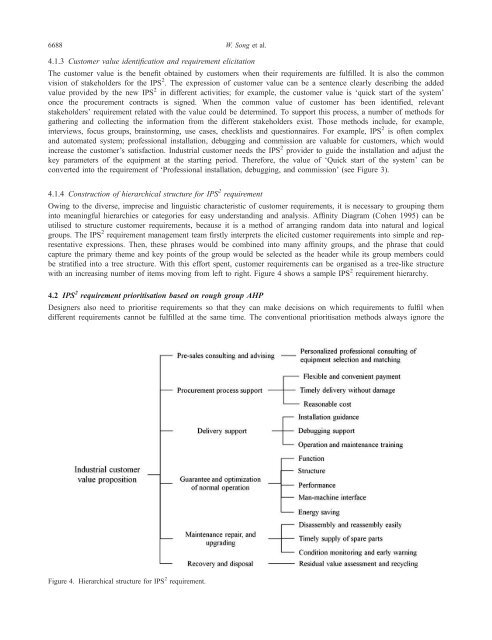A rough set approach for evaluating vague customer requirement of industrial product-service system_Wenyan Songa
You also want an ePaper? Increase the reach of your titles
YUMPU automatically turns print PDFs into web optimized ePapers that Google loves.
6688 W. Song et al.<br />
4.1.3 Customer value identification and <strong>requirement</strong> elicitation<br />
The <strong>customer</strong> value is the benefit obtained by <strong>customer</strong>s when their <strong>requirement</strong>s are fulfilled. It is also the common<br />
vision <strong>of</strong> stakeholders <strong>for</strong> the IPS 2 . The expression <strong>of</strong> <strong>customer</strong> value can be a sentence clearly describing the added<br />
value provided by the new IPS 2 in different activities; <strong>for</strong> example, the <strong>customer</strong> value is ‘quick start <strong>of</strong> the <strong>system</strong>’<br />
once the procurement contracts is signed. When the common value <strong>of</strong> <strong>customer</strong> has been identified, relevant<br />
stakeholders’ <strong>requirement</strong> related with the value could be determined. To support this process, a number <strong>of</strong> methods <strong>for</strong><br />
gathering and collecting the in<strong>for</strong>mation from the different stakeholders exist. Those methods include, <strong>for</strong> example,<br />
interviews, focus groups, brainstorming, use cases, checklists and questionnaires. For example, IPS 2 is <strong>of</strong>ten complex<br />
and automated <strong>system</strong>; pr<strong>of</strong>essional installation, debugging and commission are valuable <strong>for</strong> <strong>customer</strong>s, which would<br />
increase the <strong>customer</strong>’s satisfaction. Industrial <strong>customer</strong> needs the IPS 2 provider to guide the installation and adjust the<br />
key parameters <strong>of</strong> the equipment at the starting period. There<strong>for</strong>e, the value <strong>of</strong> ‘Quick start <strong>of</strong> the <strong>system</strong>’ can be<br />
converted into the <strong>requirement</strong> <strong>of</strong> ‘Pr<strong>of</strong>essional installation, debugging, and commission’ (see Figure 3).<br />
4.1.4 Construction <strong>of</strong> hierarchical structure <strong>for</strong> IPS 2 <strong>requirement</strong><br />
Owing to the diverse, imprecise and linguistic characteristic <strong>of</strong> <strong>customer</strong> <strong>requirement</strong>s, it is necessary to grouping them<br />
into meaningful hierarchies or categories <strong>for</strong> easy understanding and analysis. Affinity Diagram (Cohen 1995) can be<br />
utilised to structure <strong>customer</strong> <strong>requirement</strong>s, because it is a method <strong>of</strong> arranging random data into natural and logical<br />
groups. The IPS 2 <strong>requirement</strong> management team firstly interprets the elicited <strong>customer</strong> <strong>requirement</strong>s into simple and representative<br />
expressions. Then, these phrases would be combined into many affinity groups, and the phrase that could<br />
capture the primary theme and key points <strong>of</strong> the group would be selected as the header while its group members could<br />
be stratified into a tree structure. With this ef<strong>for</strong>t spent, <strong>customer</strong> <strong>requirement</strong>s can be organised as a tree-like structure<br />
with an increasing number <strong>of</strong> items moving from left to right. Figure 4 shows a sample IPS 2 <strong>requirement</strong> hierarchy.<br />
4.2 IPS 2 <strong>requirement</strong> prioritisation based on <strong>rough</strong> group AHP<br />
Designers also need to prioritise <strong>requirement</strong>s so that they can make decisions on which <strong>requirement</strong>s to fulfil when<br />
different <strong>requirement</strong>s cannot be fulfilled at the same time. The conventional prioritisation methods always ignore the<br />
Figure 4. Hierarchical structure <strong>for</strong> IPS 2 <strong>requirement</strong>.



